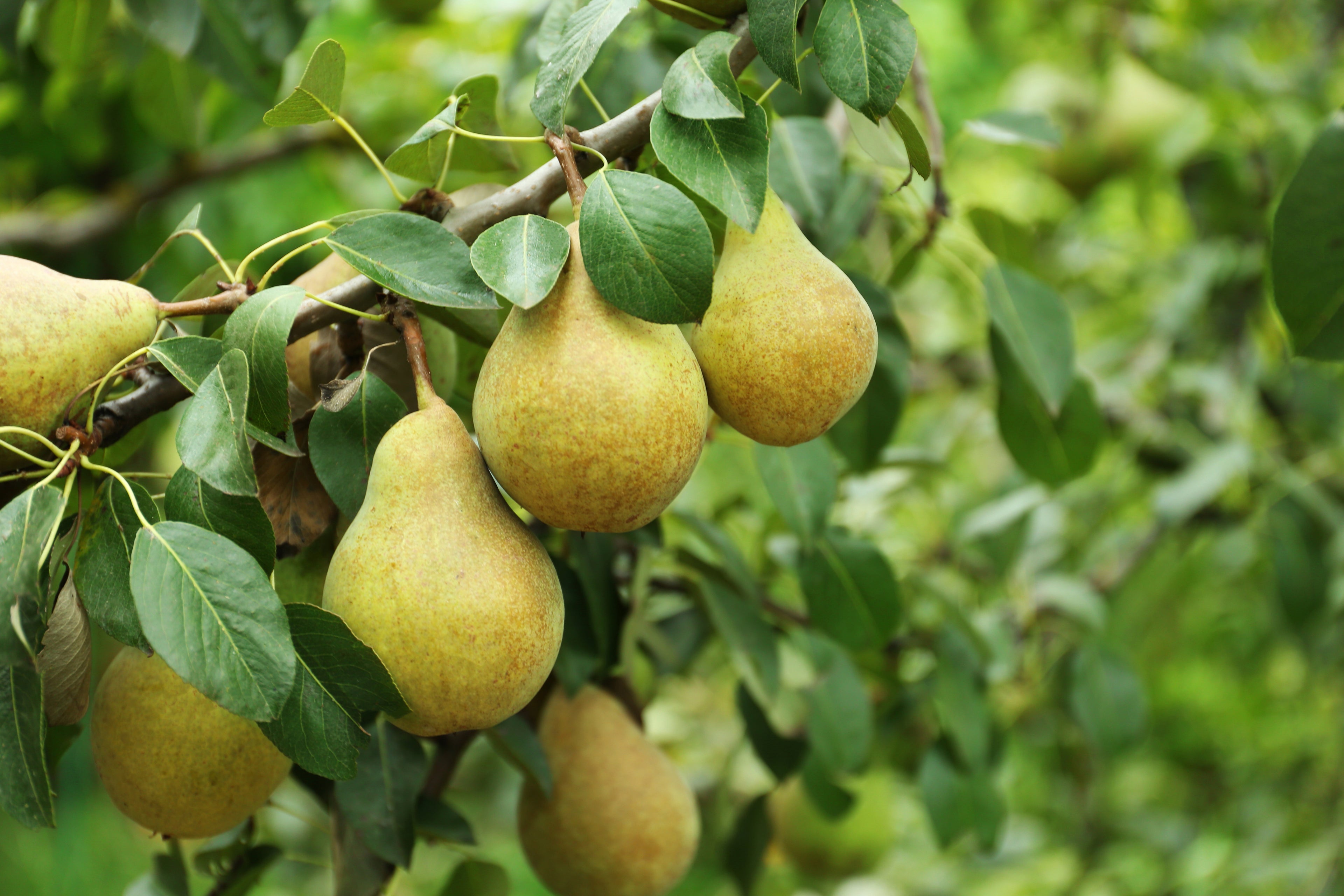
Pear Trees
Oregon is among the top in nation for pear production, and pears are considered Oregon’s state fruit. Essentially, pears grow great in Oregon, and make a great addition to a home orchard.
Collapsible content
CARE
There are three main types of pears, European summer, European winter, and Asian. European pears have a soft texture and ripen off the tree, while Asian pears are crisp and apple-like and ripen on the tree. European and Asian pears grow best in full sun with well drained soil, although they can tolerate more clayey and wet soil compared to other fruit trees. Pears, like most fruit trees benefit from annual fertilization. Planting in ideal conditions with yearly maintenance are a growers first preventative techniques for combating diseases but, depending on the variety, pears grown in the Willamette valley are more or less subject to fireblight, and pear scab and benefit from a pest management strategy.
ROOTSTOCK
Pears will grow to be large or small, it is all dependent on the rootstock they are grafted on to.
European Pear:
Dwarf- A dwarf pear tree will grow 8-10′ tall by 5-7′ wide. They are usually the earliest to mature and bear fruit, and typically produce 1-3 bushel a tree. They usually benefit from staking.
Semi-Dwarf- A semi-dwarf pear tree will grow 12-15′ tall 10′ wide. They are slower to bear fruit then dwarf, but will produce a larger amount, typically 2-3 bushels a tree. They commonly do not require staking.
Standard- A standard pear tree will grow 18′ x 13′ or larger. They often take longer to bear fruit, but bear the most fruit, typically 3-6 bushels a tree. They are very sturdy and require no staking.
Asian Pear:
Dwarf- A dwarf pear tree will grow 8-10′ tall by 5-7′ wide. They are usually the earliest to mature and bear fruit, and typically produce 2-3 bushel a tree. They usually benefit from staking.
Semi-Dwarf- A semi-dwarf pear tree will grow 12-15′ tall 10′ wide. They are slower to bear fruit then dwarf, but will produce a larger amount, typically 2-4 bushels a tree. They commonly do not require staking.
Standard- A standard pear tree will grow 18′ x 13′ or larger. They often take longer to bear fruit, but bear the most fruit, typically 4-6 bushels a tree. They are very sturdy and require no staking.
POLLINATION
In order for pears to set fruit they need to be pollinated. Pears are most commonly pollinated by honey bees. European and Asian pears benefit or require cross-pollination. Cross pollination will occur when two or more differing varieties of compatible pears are planted within the same vicinity and bloom at the same or overlapping times. European and Asian pears are cross-compatible.

Asian Pears
SEMI-DWARF
-
Yakumo
Zone: 5
15′ x 10′
Harvest Season: Early August
Disease Resistance: Good
Fruits are amazingly juicy, crisp, crunchy and have a sweet melon like flavor. Slight tapered neck, instead of round shape like other Japanese pears. Very productive.
-
20th Century
Zone: 5
15′ x 10′
Harvest Season: August to September
Disease Resistance: Moderate
Slightly oblong golden fruit with a crisp, juicy, tasty white flesh. Very productive. Rapid growth makes this tree susceptible to diseases.
-
Hosui
Zone: 5
15′ x 10′
Harvest Season: Late August to September
Disease Resistance: Good
Snappy, tangy taste. Produces excellent-quality fruit with a slightly higher acid content than other Asian pears. Very productive.
European Pears
SEMI-DWARF
-
Anjou
Zone: 6
15′ x 10′
Harvest Season: September
Disease Resistance: Moderate
Large, short-necked, firm fruit of great quality. Very juicy when fully ripe with subtle sweetness and hints of a lemon-lime flavor. Great shelf life.
-
Bosc
Zone: 5
15′ x 10′
Harvest Season: Early October
Disease Resistance: Moderate
This vigorous grower is also a vigorous producer with an exceptional crop of large, russeted fruit. Tender flesh and smooth texture is perfect for fresh eating while also being well suited for canning and preserves.
-
Red Keiffer
Zone: 4
25′ x 20′
Harvest Season: Mid October
Disease Resistance: Good
The perfect pear for canning and preserves. Fruit is big and yellow.Pick your pears when still firm and yellow-green in color. Then store at 60-70 degrees F to allow pears to finish ripening. Blight resistant and bears young.
-
Red Anjou
Zone: 5
15′ x 10′
Harvest Season: September
Disease Resistance: Moderate
A vigorous upright tree with white spring flowers. Large, short-necked, firm fruit of great quality. Juicy, mild flavor and fine textured. Stores well.
-
Red Bartlett
Zone: 5
15′ x 10′
Harvest Season: August to September
Disease Resistance: Low to moderate
The skin color brightens as it ripens! It turns from dark red to bright red when ready to eat. Has a higher sugar content than its Bartlet counter part. Pollinate with Bosc or D, Anjou, also partially self-fertile.
-
Summercrisp
Zone: 3
15′ x 10′
Harvest Season: Mid August
Disease Resistance: Good
Blanketed with white flowers in spring. Sweet green fruit blushes with red when ripe. Small firm, crisp and juicy fruit with good flavor. Lasts up to 6 weeks in the fridge. Self fertile.